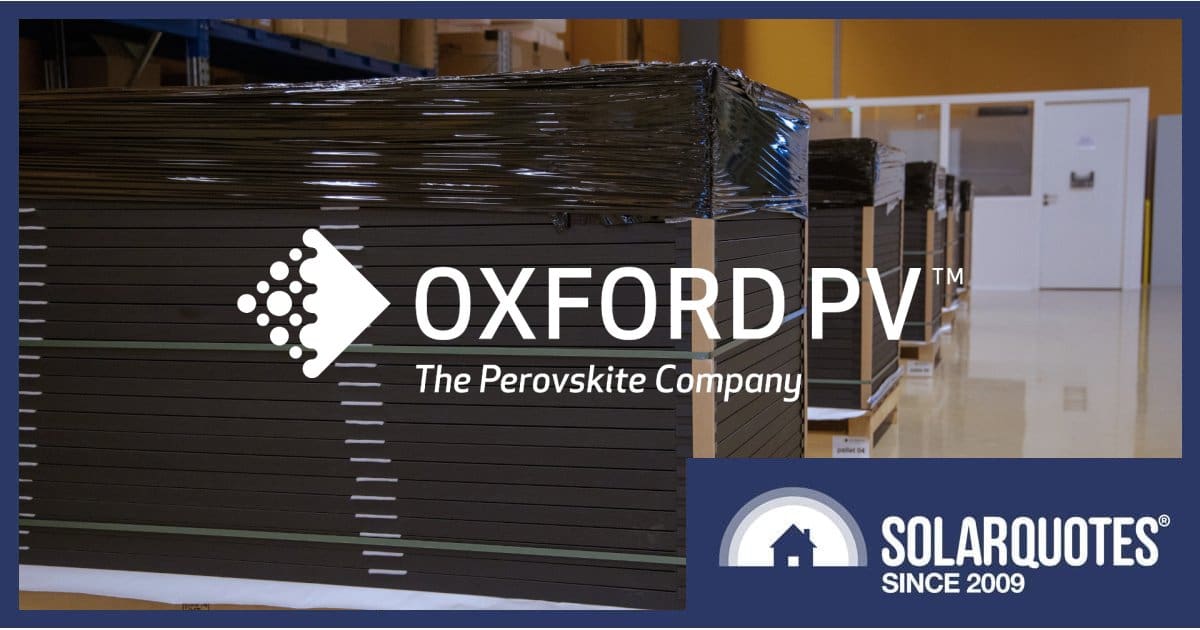
Perovskite solar panels on residential rooftops may be a step closer, with Oxford PV announcing what it says is the world-first commercial sale of modules.
Perovskite materials have semiconductor attributes and there has been much research carried out over the last 15 years into using them in the manufacture of solar cells. Perovskite occurs naturally as a calcium titanium oxide mineral, but perovskite crystal structures can also be synthetically manufactured using low-cost fabrication methods.
While silicon has been the material of choice for commercially produced solar panels for decades, we’re closing in on a maximum conversion efficiency limit of 29% – 31%. One of the advantages of using perovskite cells is a theoretical conversion efficiency limit of 43%.
But a major challenge for these materials has been stability, with early efforts quickly degrading – and much of the research since has been around addressing this.
Commercialisation A “Breakthrough”
Oxford PV is among the companies that have been pursuing perovskite tech. The firm was established in 2010 as a spin-off from Professor Henry Snaith’s lab at the University of Oxford in the UK. Today, it has a research and development site in Oxford, and a megawatt-scale pilot line in Brandenburg an der Havel near Berlin in Germany.
Oxford PV began to focus on perovskite-silicon tandem solar cell development in 2014. These cells have a conventional silicon bottom cell with a perovskite top cell.
“This enhances the performance of silicon solar cells on the same footprint, enabling cost reductions that transform the economics of silicon solar energy generation,” states the firm.
Last week, the company announced it had started the commercialisation of its tandem solar technology with the first shipment to a U.S-based customer for a utility-scale installation.
“The commercialisation of this technology is a breakthrough for the energy industry,” said Oxford PV CEO David Ward. “High-efficiency technologies are the future of the solar industry, and that future is starting now.”
This initial batch of 72-cell panels have a 24.5% module efficiency. Looking at the SolarQuotes solar panel comparison table, the (silicon) modules currently listed have conversion efficiencies ranging from 20.2% to 23%.
As to which company the first panels went to, how many, warranty details and further module specifications, that information hasn’t been shared yet unfortunately – not even a decent pic. But Oxford PV says it will continue to allocate production from their pilot facility towards more utility customers, specialty products and pilot residential applications, and plans ramping up to gigawatt-scale at a future manufacturing site.
On the residential side of things, Oxford PV recently achieved a silicon-perovskite tandem cell module efficiency of 26.9%. This was a 60-cell double-glass module just over 1.6 m2 and weighing under 25 kg.
Other Perovskite Players Of Note
Oxford PV isn’t the only company making solid progress in the pursuit of perovskite-silicon solar tech development. For example, JinkoSolar announced in May this year its N-type TOPCon-based perovskite tandem solar cell achieved a conversion efficiency of 33.24%. Another solar manufacturing giant, Longi, said in June it had achieved 34.6% efficiency with a tandem cell.
As for stability issues, GCL Technology claimed in July its latest tandem-cell module met IEC testing standards; suggesting degradation similar to standard silicon solar modules. But the company said the tests were designed to degrade silicon and not perovskite products . It’s also worth noting GCL said its “pure” perovskite modules have been in use at a 1 MW project deployed by China Three Gorges since late 2023.
The company intends beginning mass production in late 2025.

 RSS - Posts
RSS - Posts



See also this ABC article about hybrid Perovskite Solar Panels
“Indoor solar power could replace disposable batteries and charger cables with photovoltaic strips”
https://www.abc.net.au/news/science/2024-09-11/indoor-solar-power-could-replace-batteries-and-charger-cables/104301316
It explains some of the current limitations and potential advantages of Perovskite.